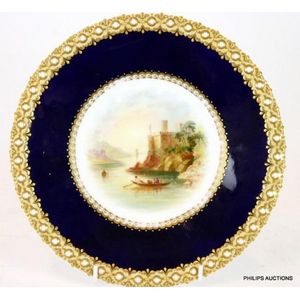Dartmouth Castle Coalport Cabinet Plate, 19th Century Victorian Porcelain
A 'Dartmouth Castle' cabinet plate, probably Coalport, 19th century, the Victorian porcelain plate with hand painted view of Dartmouth castle surrounded by gilded, cobalt blue border jewelled moulded border to the rim, unmarked. Provenance: Havelock house Antiques, Goolwa (label) diameter: 23.5 cm
You must be a subscriber, and be logged in to view price and dealer details.
Subscribe Now to view actual auction price for this item
When you subscribe, you have the option of setting the currency in which to display prices to $Au, $US, $NZ or Stg.
This item has been sold, and the description, image and price are for reference purposes only.
- Jewelled Decoration - Jewelled decoration on ceramics is a technique where small, colourful, and often metallic beads or "jewels" are applied to the surface of ceramic objects to create intricate and highly decorative designs. This technique has been used throughout history and across different cultures, but it was particularly popular during the late 19th and early 20th centuries, especially in Europe.
The jewelled decoration is usually applied by hand, one bead at a time, onto a base glaze or enamel. The beads can be made of glass, porcelain, or even precious stones, and are often set in a metal setting, such as gold or silver. The end result is a highly decorative and often luxurious surface, which can add a lot of visual interest and value to the ceramic object.
Jewelled decoration was used on a wide range of ceramic objects, including vases, plates, bowls, and figurines. It was particularly popular in the Art Nouveau and Art Deco periods, where it was used to create highly stylized and ornate designs. - Victorian Period - The Victorian period of furniture and decorative arts design covers the reign of Queen Victoria from 1837 to 1901. There was not one dominant style of furniture in the Victorian period. Designers used and modified many historical styles such as Gothic, Tudor, Elizabethan, English Rococo, Neoclassical and others, although use of some styles, such as English Rococo and Gothic tended to dominate the furniture manufacture of the period.
The Victorian period was preceded by the Regency and William IV periods, and followed by the Edwardian period, named for Edward VII (1841 ? 1910) who was King of the United Kingdom and the British Dominions and Emperor of India for the brief period from 1901 until his death in 1910. - Gilding - Gilding is a method of ornamentation whereby a thin sheet of gold metal is applied to items made of wood, leather, ceramics, glass and silver for decorative purposes.
For furniture including mirrors, the sheet of gold is usually applied over a coating of gesso. Gesso is a mixture of plaster of Paris and gypsum mixed with water and then applied to the carved wooden frames of mirrors and picture frames as a base for applying the gold leaf. After numerous coats of gesso have been applied, allowed to dry and then sanded a coat of "bole", a usually red coloured mixture of clay and glue is brushed on and allowed to dry, after which the gold leaf is applied. Over time parts of the gilding will rub off so the base colour can be seen. In water gilding, this was generally a blue colour, while in oil gilding, the under layer was often yellow. In Victorian times, gilders frequently used red as a pigment beneath the gold leaf.
Metal was often gilded by a process known as fire gilding. Gold mixed with mercury was applied and heated, causing the mercury to evaporate, the long-term effect of which was to kill or disable the craftsman or woman from mercury poisoning. The pursuit of beauty has claimed many victims, not the least of which were the artists who made those pieces so highly sought after today.
This item has been included into following indexes:
